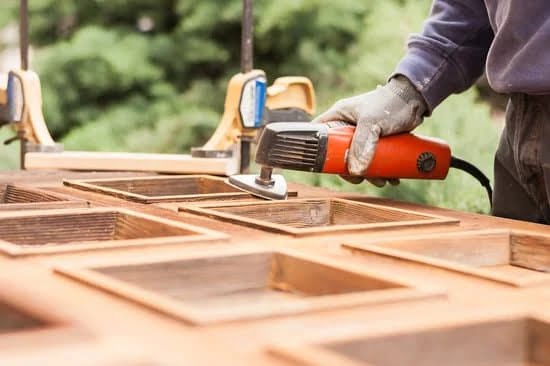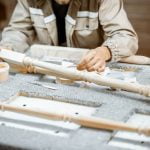Are you a woodworking enthusiast looking to improve the functionality of your workbench? If so, then understanding the importance of a front bench vise is crucial for your woodworking projects. In this article, we will guide you through the process of making a woodworker’s front bench vise, providing step-by-step instructions and tips for customization.
A front bench vise is an essential tool for any woodworking shop, allowing for secure clamping and holding of materials while working on them. Whether you are constructing furniture, shaping wood, or carrying out intricate detailing, a sturdy and reliable bench vise is indispensable. By learning how to make your own woodworker’s front bench vise, you can tailor it to suit your specific needs and gain a sense of accomplishment from building it yourself.
In the following sections, we will discuss the tools and materials needed for creating a woodworker’s front bench vise, provide a step-by-step guide on building the main body and moving parts of the vise, as well as guidance on proper installation and maintenance. Additionally, we will explore customization options that allow you to add features and modifications for personalized use.
So let’s roll up our sleeves and delve into the world of DIY woodworking tools by starting with the creation of a front bench vise.
Tools and Materials Needed for Making a Woodworker’s Front Bench Vise
Now, let’s discuss the tools and materials needed for making a woodworker’s front bench vise. Building your own front bench vise can be a rewarding and cost-effective project, but it does require the use of specific tools and materials to ensure its functionality and durability.
First and foremost, you will need a sturdy workbench or bench top on which to mount your front bench vise. In addition to this, you will need a variety of woodworking hand tools such as chisels, mallets, hand saws, and clamps to help with the construction of the vise.
In terms of materials, you will need a stable and durable wood for the main body of the vise such as maple or oak. You will also need metal hardware components such as threaded rods, nuts, washers, and screws to create the moving parts of the vise. Additionally, consider using wood glue and finish to enhance the appearance and longevity of your front bench vise.
With these tools and materials in hand, you are well-equipped to embark on building your very own woodworker’s front bench vise. Be sure to gather all necessary items before beginning construction in order to streamline the process and minimize interruptions.
Step-by-Step Guide on Building the Main Body of the Bench Vise
Building the main body of a woodworker’s front bench vise is a crucial step in creating a sturdy and reliable tool for woodworking projects. This component is responsible for providing the strength and support needed to hold workpieces securely in place while they are being worked on. To start this process, you will need to gather the necessary tools and materials, including a solid piece of hardwood for the main body, a drill press, wood glue, clamps, and screws.
Begin by cutting the hardwood to the desired dimensions for the main body of the bench vise using a saw. It is important to choose a hardwood that is durable and able to withstand heavy pressure. Next, use a drill press to create holes along one side of the main body piece.
These holes will serve as guides for attaching the moving parts of the bench vise later on. Once the holes are drilled, it’s time to assemble the main body by applying wood glue to the joints and securing them together with clamps. It may also be beneficial to reinforce these joints with screws for added stability.
After allowing time for the wood glue to dry, remove the clamps and proceed to sand down any rough edges or surfaces on the main body of the bench vise. This will ensure smooth movement when adding in the moving parts later on in the construction process. By taking these steps and following this guide closely, you can effectively produce a solid and well-constructed foundation for your woodworker’s front bench vise.
Adding the Moving Parts
To make the jaw of the bench vise, you will need a sturdy piece of hardwood that is able to withstand the pressure and force exerted during clamping. Maple or oak are popular choices for making vise jaws due to their durability and strength.
Begin by cutting the wooden block to the desired size and shape, ensuring that it fits snugly within the main body of the vise. You can then drill holes for attaching the jaw to the vise using screws or bolts, ensuring that it moves smoothly and without any wobbling.
Next, let’s focus on creating the handle for the bench vise. The handle is what allows you to tighten and release the vise, so it needs to be strong and easy to grip. A common design for a vise handle is a simple wooden bar with a contoured grip for comfortable handling.
You can carve or sand the wood into the desired shape, making sure to create a smooth surface that won’t cause discomfort when tightened. Once completed, attach the handle securely to the movable part of your bench vise so that it can easily rotate when clamping materials.
| Component | Material | Size/Dimensions |
|---|---|---|
| Jaw | Hardwood (Maple or Oak) | Customizable based on workbench size |
| Handle | Wooden bar with contoured grip | Depends on personal preference for grip size |
Creating these moving parts requires meticulous attention to detail and precision in order to ensure smooth operation of your woodworker’s front bench vise. With these essential components in place, you’ll be one step closer towards having a fully functional bench vise for your woodworking projects.
Proper Installation and Mounting of the Front Bench Vise to a Workbench
When it comes to woodworking, having a reliable front bench vise is essential for securing workpieces in place. Proper installation and mounting of the front bench vise to a workbench is crucial to ensure stability and safety during woodworking projects. Here’s how you can install and mount your DIY woodworker’s front bench vise:
1. Determine the placement: Before installing the front bench vise, carefully consider where it will be most functional on your workbench. Take into account the size of your workpieces and the range of motion needed for the vise.
2. Mark the mounting holes: Once you’ve decided on the location for your front bench vise, mark the position of the mounting holes on your workbench. Use a pencil or marker to ensure accurate placement.
3. Drill pilot holes: With a drill and appropriate drill bit, create pilot holes at the marked positions on your workbench. This will make it easier to screw in the bolts for mounting.
4. Secure the vise to the workbench: Place the front bench vise over the pilot holes and align it with them accordingly. Use screws or bolts to secure the vise to the workbench through the drilled pilot holes.
5. Test for stability: After mounting the front bench vise, test its stability by securing various sizes of workpieces within it. Ensure that it holds firmly without any wobbling or movement.
Mounting a front bench vise requires attention to detail and precision to ensure its effectiveness in woodworking projects. By following these steps, you can properly install and mount your woodworker’s front bench vise to your workbench, providing a reliable tool for holding workpieces securely in place.
Additional Tips:
Tips for Maintaining and Ensuring the Smooth Operation of the Woodworker’s Front Bench Vise
Maintaining and ensuring the smooth operation of a woodworker’s front bench vise is essential for achieving quality woodworking results. Proper care and maintenance can extend the lifespan of the vise, while ensuring that it operates effectively. Here are some tips to help you keep your front bench vise in top condition.
Clean and Lubricate Regularly
Dust, dirt, and debris can accumulate on the moving parts of the bench vise, leading to friction and difficulty in operation. It is important to regularly clean the vise with a brush or compressed air to remove any buildup. Additionally, applying a small amount of lubricant to the moving parts can help reduce friction and ensure smooth operation. Be sure to use a lubricant that is safe for use on woodworking tools and equipment.
Inspect for Wear and Damage
Regularly inspect the woodworker’s front bench vise for any signs of wear or damage. Check for any cracks or dents in the main body, as well as any wear on the jaw or handle. By catching any issues early, you can prevent further damage and make necessary repairs before they become more serious.
Proper Use
Ensure that you are using your front bench vise properly to avoid putting unnecessary strain on its components. Over-tightening the vise can lead to premature wear, so be mindful of how much force you are applying when clamping pieces of wood. Additionally, avoid using the vise for tasks it was not designed for, as this can also cause damage.
By following these tips, you can maintain the smooth operation of your woodworker’s front bench vise and ensure that it remains an essential tool in your woodworking projects for years to come.
Customization Options
When it comes to woodworking, having a front bench vise that is tailored to your specific needs and preferences can make a world of difference in the quality of your work. While a standard bench vise may serve its purpose, customizing your own bench vise can elevate your woodworking experience to the next level. In this section, we will explore various customization options that woodworkers can consider when creating their own front bench vise.
Material Selection and Design Modifications
One of the first considerations for customization is the material selection for the bench vise. Woodworkers can choose different types of wood or metal for the construction, depending on their preference for durability and aesthetics. Additionally, design modifications such as decorative carvings, inlays, or personalized engravings can add a unique touch to the bench vise.
Enhanced Functionality
Woodworkers can also customize their front bench vise to enhance its functionality based on their specific woodworking needs. This can include adding wider jaws for clamping larger pieces of wood, incorporating quick-release mechanisms for efficient operation, or integrating sliding features for adjustable positioning.
Specialized Accessories
Another way to personalize a woodworker’s front bench vise is by adding specialized accessories that cater to individual requirements. This could involve attaching additional dog holes for holding irregularly shaped workpieces securely in place, incorporating an adjustable stop block for repetitive tasks, or installing soft jaw pads to protect delicate materials during clamping.
By customizing a woodworker’s front bench vise with these personalized features and modifications, individuals can create a tool that not only meets their specific needs but also reflects their craftsmanship and creativity in woodworking. Whether it’s through material selection, design alterations, enhanced functionality, or specialized accessories, customizing a bench vise allows woodworkers to tailor this essential tool to their liking.
Through careful planning and execution of these customization options, woodworkers can create a front bench vise that is not only practical and efficient but also imbued with personal touches that make it truly one-of-a-kind.
Conclusion
In conclusion, making your own woodworker’s front bench vise not only saves you money, but it also allows you to create a customized tool that meets your specific woodworking needs. The satisfaction and sense of accomplishment from building it yourself is unparalleled, and the knowledge and skills gained from the process are invaluable.
By following the step-by-step guide and using the necessary tools and materials, you can easily create a functional and durable bench vise that will serve you well in countless woodworking projects.
One of the main benefits of building your own front bench vise is the customization options it offers. You can add features and modifications that cater to your unique preferences and working style. This level of personalization is rarely found in store-bought bench vises, making DIY construction an attractive option for woodworkers who value versatility.
Additionally, by understanding how to make a woodworker’s front bench vise, you also gain insight into the mechanics and functionality of this essential tool. This knowledge not only enhances your woodworking skills but also empowers you to make any necessary repairs or adjustments in the future. With proper maintenance, your homemade bench vise will provide reliable support for all your woodworking endeavors for years to come.
Frequently Asked Questions
How Do You Make a Vice Workbench?
Making a vice workbench involves attaching the vice to a sturdy work surface, typically made of wood or metal. This requires measuring, drilling holes, and securely fastening the vice in place to ensure stability and functionality.
What Is the Best Wood for a Bench Vise?
The best wood for a bench vise is hardwood, such as maple or beech, due to its durability and strength. Softwoods like pine are not suitable for heavy-duty clamping as they are more prone to denting and deformation under pressure.
How to Make a Workbench Moxon Vise?
To make a workbench Moxon vise, you’ll need to create two wooden jaws with holes for the screws to pass through. These jaws should be attached to metal screws that will serve as the clamping mechanism. Proper assembly and alignment are crucial for smooth operation and precise woodworking tasks.

Hi everyone! I’m a woodworker and blogger, and this is my woodworking blog. In my blog, I share tips and tricks for woodworkers of all skill levels, as well as project ideas that you can try yourself.





